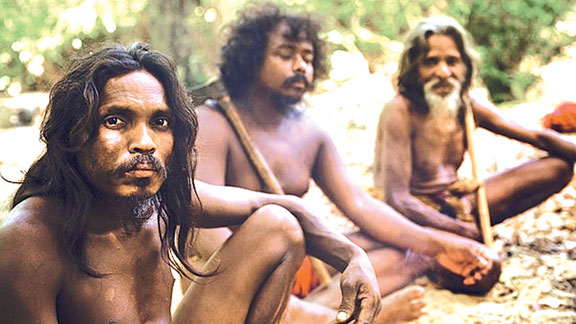Better future for indigenous peoples
 Migration has helped most countries to prosper. But the fact is that long
before the migrants came, most countries did have people – an indigenous
population. This is a familiar tale of newcomers virtually taking over a
country, pushing aside the indigenous population. They have often been forced to
become virtually second class citizens in their own countries, sometimes denied
basic rights such as land, housing and even the vote. Migration has helped most countries to prosper. But the fact is that long
before the migrants came, most countries did have people – an indigenous
population. This is a familiar tale of newcomers virtually taking over a
country, pushing aside the indigenous population. They have often been forced to
become virtually second class citizens in their own countries, sometimes denied
basic rights such as land, housing and even the vote.
There are an estimated 370 million indigenous people in the world, living across
90 countries including Sri Lanka (Adivasis). They make up less than five per
cent of the world’s population, but account for 15 per cent of the poorest. They
speak an overwhelming majority of the world’s estimated 7,000 languages and
represent 5,000 different cultures. There is a real danger of some of these
societies and cultures going extinct, forever burying the customs, traditions
and languages. In fact, more than half of the world’s languages are already in
danger because there are so few native speakers.
In 1994, the United Nations General Assembly decided that the International Day
of the World’s Indigenous Peoples shall be observed on 9 August every year. The
date marks the day of the first meeting, in 1982, of the UN Working Group on
Indigenous Populations of the Sub-Commission on the Promotion and Protection of
Human Rights.
Cooperation
In 1990, the UN General Assembly proclaimed 1993 the International Year of the
World’s Indigenous Peoples. Later, the General Assembly established two
International Decades of the Indigenous Peoples, with the goal of strengthening
international cooperation for solving problems faced by indigenous people -
World’s Indigenous Peoples: the first 1995 - 2004, and the second 2005-2014 in
areas such as human rights, the environment, development, education, health,
economic and social development.
Every year the day is celebrated under a different theme. This year’s (2016)
International Day of the World’s Indigenous Peoples is devoted to their Right to
Education.
The right of indigenous peoples to education is protected by the UN Declaration
on the Rights of Indigenous Peoples, which in Article 14 states that “Indigenous
peoples have the right to establish and control their educational systems and
institutions providing education in their own languages, in a manner appropriate
to their cultural methods of teaching and learning.” The right of indigenous
peoples to education is also protected by a number of other international human
rights instruments, including the Universal Declaration of Human Rights.
Training
 Goal 4 of the 2030 Agenda for Sustainable Development calls for ensuring equal
access to all levels of education and vocational training for the vulnerable,
including persons with disabilities, indigenous peoples and children in
vulnerable situations. According to the UN, in spite of these instruments, the
right to education has not been fully realised for most indigenous peoples, and
a critical education gap exists between indigenous peoples and the general
population. Existing data shows consistent and persistent disparities between
the indigenous and the non-indigenous population in terms of educational access,
retention and achievement, in all regions of the world. And just as it is in the
mainstream society in many countries, women and girls in indigenous communities
are often left behind when it comes to the available educational opportunities. Goal 4 of the 2030 Agenda for Sustainable Development calls for ensuring equal
access to all levels of education and vocational training for the vulnerable,
including persons with disabilities, indigenous peoples and children in
vulnerable situations. According to the UN, in spite of these instruments, the
right to education has not been fully realised for most indigenous peoples, and
a critical education gap exists between indigenous peoples and the general
population. Existing data shows consistent and persistent disparities between
the indigenous and the non-indigenous population in terms of educational access,
retention and achievement, in all regions of the world. And just as it is in the
mainstream society in many countries, women and girls in indigenous communities
are often left behind when it comes to the available educational opportunities.
The education sector not only mirrors the historical abuses, discrimination and
marginalization suffered by indigenous peoples, but also reflects their
continued struggle for equality and respect for their rights as peoples and as
individuals. However, there is another side to the education angle – indigenous
youth who enter a country’s formal education system may assimilate to the
mainstream society, leaving the indigenous lifestyle behind. While assimilation
is not a bad thing per se, this has the potential to threaten the existence of a
given indigenous group in the long term. Therefore, a balance has to be struck
to preserve the indigenous way of life – hence the call to fit in their
education patterns to their ways of life.
Incidentally, armed conflicts around the world have also affected the
educational prospects of indigenous peoples. The most affected are indigenous
people caught in crossfires in current and past armed conflicts in Colombia,
India, Myanmar, the Philippines, Bangladesh, Guatemala and Peru, according to
Victoria Tauli-Corpuz of the Philippines, the UN Special Rapporteur on the
Rights of Indigenous People. The grave consequences include forced displacement,
extra-judicial executions, sexual violence and forced recruitment of child
soldiers from indigenous communities. Sometimes, physical remnants of wars such
as landmines affect the indigenous communities long after the conflict ends.
These issues were in focus at a recent international seminar on “Indigenous
People: Conflict, Peace and Resolution” in which more than 1,000 indigenous
people’s representatives participated.
Mistakes
However, Governments around the world are also acknowledging the mistakes they
may have made with regard to the marginalization of indigenous communities. For
example, the Taiwanese leader recently formally apologoised to the island’s
indigenous people for the discrimination they faced for centuries. Several other
countries have made similar apologies to their indigenous communities.
This is an acknowledgement that the indigenous people deserve to be respected,
not marginalized. Since they have a closer affinity to the environment and
ancient ways of life, they may be our best bet against environmental destruction
as well. “Indigenous people across the world are the ones keeping the human race
from destroying itself and leading earth to a disaster as they gain voices in
countries in Latin America, the United States and Australia,” renowned political
commentator and academic Noam Chomsky said in a recent interview. Chomsky’s
comments come as many Indigenous groups across Latin America are becoming more
involved in the continent’s politics while also pushing back against global
corporations who for decades have exploited their lands and resources for
profit.
This is a good omen for indigenous populations the world over. In Sri Lanka,
Uruwarige Wanniyela Aththo, the leader of the Adivasi Community has been an
outstanding spokesman for his community which has fought back on many issues
from assimilation to hunting rights. The courage to stand up on issues affecting
the indigenous communities including education must come from within, but
Governments must also heed the call to protect their rights, traditions and
cultures. |

